- Source:
- YsPhoto / © PIXTA / Chinku / © PIXTA / © PR Times Inc. / © PR Times Inc. / © Socialwire Co., Ltd. / © Daimaru Matsuzakaya Department Stores Co., Ltd. / © The Journal of Comparative Folklore / © The Asahi Shimbun Company / KSL-Live!
- Tags:
- asanoha / bean-throwing / beans / Competition / demon / devil / ehomaki / embarrassing / entertainment / Expensive / extravagant / family-oriented / futomaki / gargoyle / good fortune / hemp-leaf pattern / invented tradition / lattice windows / lewd / luxurious / Luxury / mamemaki / Nagoya / Nagoya Castle / Nori / oni / opulent / Osaka / Promotion / Seafood / Seaweed / Setsubun / shachi / showy / sold out / spring solstice / Sushi / upscale / wasted food / yujo
Related Article
-
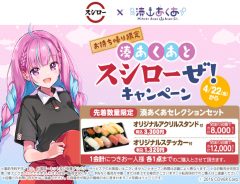
Enjoy delicious sushi at home with Minato Aqua!
-

Are You Down With Strawberry and Balsamic Vinegar Sushi? This Department Store Is!
-
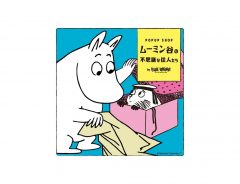
Moomin popup shop: The residents of Moominvalley come to Village Vanguard
-

Petite YouTuber eats sumo-sized 4000 kcal of grape jelly and chugs a 1000 kcal giant coffee
-
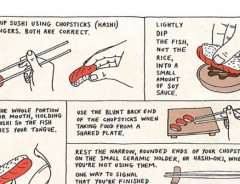
How Do You Eat Sushi Correctly? Here Are Some Illustrations To Help
-
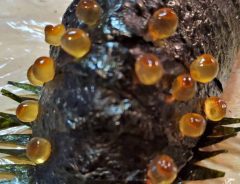
Sushi Challenge with Ghibli-Inspired and King-Sized Creations
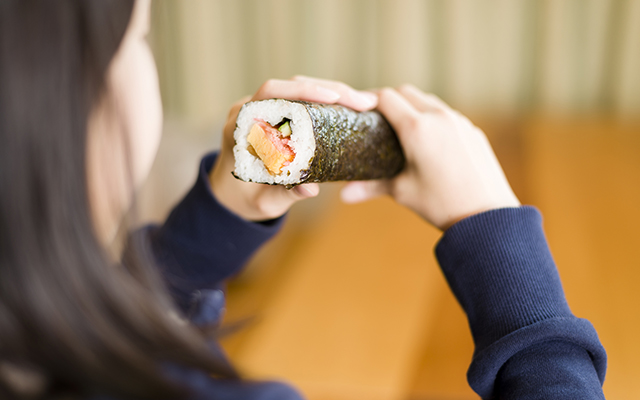


Ehomaki Origins: Naughty Games and Nori Sales
Setsubun, the day before the beginning of spring in Japan, is mostly known for two traditional practices, one is mamemaki, throwing beans (or peanuts in some regions) outside or at someone wearing a demon mask while yelling: "Out with the demons, in with good fortune," or some variant thereof.
The other one is eating ehomaki. Ehomaki 恵方巻, literally meaning "lucky direction roll," is a long futomaki sushi roll often containing kanpyō (pickled gourd), egg, eel, and shiitake mushrooms, and possibly numerous other ingredients, all of it eaten to wish for good luck. Custom has it the ehomaki is to be eaten at once and continuously, without removing it from your mouth, completely in silence, while holding it facing the auspicious direction of the year. In 2018, the direction was south southeast, and in 2019 it will be east northeast. Although formerly unknown outside of Osaka and the Kansai area, since the 90s, convenience stores and supermarket chains began to popularize it and it is now known throughout the entire country.
Source: © flickr.com / ©sakura_chihaya+
If you have ever seen someone actually eating an ehomaki in the prescribed manner, it does look a bit odd, perhaps even embarrassing to some. As it turns out, those who feel embarrassed may in fact be justified. In a study published in the March 2009 issue of the Journal of Comparative Folklore, Hiroyuki Kutsuzawa (Japanese Society of Ethnology) explains that ehomaki possibly traces its origins to a naughty game enjoyed behind the lattice-windowed houses of pleasure of Osaka. Yujo (courtesans) were apparently asked by their clients to suggestively eat a whole sushi roll all at once as a kind of entertainment.
Source: Chinku / © PIXTA
Although its origins cannot be determined with any certainty, what is clear is that the practice began to be enjoyed (without any sexual connotation) domestically already in the late Meiji Era. Subsequently, the nori seaweed industry saw an opportunity in promoting the practice commercially. For example, a flier published by the Nori Manufacturers Union in Osaka in 1932 promoted eating a sushi roll whole to bring about good fortune in the family. After the Pacific War, the Kansai nori industry stepped up its efforts with sushi roll eating contests and more promotions, and the mass media complied.
However, it wasn't until the turn of the century that ehomaki began gaining traction nationwide. The driving force behind the national boom was convenience store chain Seven Eleven, which began selling a futomaki called "Marukaburi Sushi Ehomaki" (Sushi to be eaten all at once: ehomaki) in their stores nationwide. Supermarkets and department stores soon followed suit, and in the last few years, even Okinawan stores have begun selling the ubiquitous giant sushi rolls. Ehomaki are now shown in advertisements as a fun tradition to be enjoyed by the whole family.
Ehomaki Extravagance: The Recent Trend in Upscale Ehomaki
For better or for worse, in the last few years, ehomaki have not only diverged from the traditional ingredient list and shape, but they have also reached new heights of opulence. Let's take a look at a few examples:
Source: © PR Times
The Matsuzakaya department store in Nagoya, where ehomaki have been influenced by the city's fondness for showiness, came up with the example you see above. At 7,580 JPY, this ehomaki is lavishly decorated in gold leaf with a design that locals will instantly recognize as a golden shachi gargoyle, one of several perched on the roof of Nagoya Castle.
Source: © PR Times
The same store also sold this luxurious specimen, featuring a whole lobster and premium fatty tuna, for JPY 5,184.
Source: © Socialwire Co., Ltd.
The Odakyu department store decided to create this decadent ehomaki, featuring a total of 15 ingredients including seared Matsuzaka beef, snow crab, salmon roe, caviar, truffles and roasted Japanese eel, all for the low price of JPY 7,344.
Source: © PR Times
And then, there's this "designer ehomaki" offered by Ekinaka, East Japan Railway Company's online shopping site. Wrapped with a custom-made nori sheet laser-cut in a traditional asanoha (hemp-leaf) design, it contains a panoply of premium ingredients such as yellowtail, true sea bream, sea urchin, salmon roe and snow crab.
Ehomaki Offenders: Supermarket Wars and Wasted Food
The ehomaki market has certainly become more alluring from the consumer's point of view. With a dizzying range of varieties, some reflecting recent gourmet food trends, others inspired by the culinary traditions of other countries, they are not only easily available in convenience stores and supermarkets, they also represent an out-of-the-ordinary dish which people can enjoy to create a memorable experience that will hopefully bring good fortune for the rest of the year.
However, with the growing competition between supermarkets and convenience stores to offer better and interesting ehomaki, and with consumer demand growing accordingly, stores end up producing excess supply to guarantee that they will meet demand. As featured in an article in Asahi News on Feb. 3, the end result of this situation is a prodigious amount of wasted rice, egg, vegetables, and even wasted seafood.
As reported by KSL-Live!, one supermarket chain with 8 stores in the Himeji area, Yamada Store, published an advertisement in the local newspaper asking the industry to stop wasting food and vowing that it would only produce the amount of ehomaki dictated by its sales figures from the previous year. It seems they kept their promise as they proudly slapped on "sold out" stickers to promote the message that all of their rolls had rolled out.